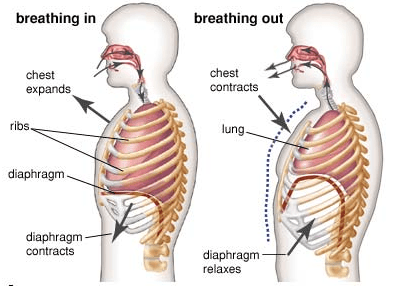Anatomy Of A Breath
The breath is composed of one inhale and one exhale at a time. Inside each inhale is the movement of the diaphragm down, towards the pelvis, making room for the expansion of the lungs as air comes into the body. During the exhale the diaphragm moves up, into the ribs, compressing the lungs and helping to expel air out of the body. Take a look at the resource entitled "The Work of the Diaphragm" at the bottom of this page for a more concrete understanding of this movement.
In yoga, we think of a complete breath as one inhale and one exhale. The inhale is expansive. Therefore in yoga, we pair expansive movements with the inhale. Expansive movements encourage and support the opening of the chest. For example, lifting the arms up is an expansive movement.
The exhale is contracting. The movements paired with the exhale are those that decrease the space in the chest or torso. Lowering the arms to the sides of the body is an example of a contracting movement.
The Work of the Diaphragm
The diaphragm is a large, dome-shaped muscle dividing the respiratory system (lungs, heart) from the digestive system (stomach, intestines). The diaphragm passively rests at within the bottom of the ribcage. When you inhale, the diaphragm becomes active, pressing downwards into the belly and making room for the expansion of the lungs as they fill with air. Place your hands on the belly while taking a big breath in and you will feel the belly expand with the pressure from the diaphragm. Conversely, the diaphragm moves upwards and into the ribcage with the exhale, pressing on the lungs to force air out. If you have your hands on the belly now, you will feel the belly release back in, towards the spine as the diaphragm moves upwards.
